-
PDF
- Split View
-
Views
-
Cite
Cite
Li Zhao, Sébastien Chevrot, An efficient and flexible approach to the calculation of three-dimensional full-wave Fréchet kernels for seismic tomography—I. Theory, Geophysical Journal International, Volume 185, Issue 2, May 2011, Pages 922–938, https://doi.org/10.1111/j.1365-246X.2011.04983.x
Close - Share Icon Share
Summary
We propose a new approach to computing the sensitivity kernels used in seismic tomography based on a Green's function database. For any perturbation in the Earth's structural model, the waveform Fréchet derivative can be expressed in terms of strain Green's tensors, which are themselves functions of the reference Earth model only. The Fréchet derivative of any seismic observable can then be obtained from waveform Fréchet derivative. Given a reference model, a strain Green's tensor database can be established, thus eliminating the need for repetitive wavefield evaluations in all subsequent synthetic and kernel calculations, and reducing the CPU time. For a spherically symmetric reference Earth model, the strain Green's tensor database can be constructed on a (r, Δ) grid by normal-mode summation. The stored strain Green's tensors can then be used to quickly evaluate the wavefield between any source and receiver. The generality of the strain Green's tensors makes it possible to compute the Fréchet kernels for any phase on a seismogram (P, S, Pdiff, surface waves, etc.), for any type of data (traveltime, amplitude, splitting intensity, waveform, etc.), and for any parameter (isotropic, anisotropic, attenuation, etc.). The kernel calculation at each point in the medium is reduced to the convolution of two sets of strain Green's tensors extracted from the database, which makes the approach extremely efficient.
1 Introduction
All the seismic waves used in seismic tomography have a finite frequency range. It is now well recognized that wave energy is not concentrated only on the ray path, but rather spreads inside a volume, the so-called Fresnel volume, surrounding the ray. In other words, a seismic wave is influenced by, or sensitive to, the structure within a Fresnel volume, usually defined by the first Fresnel zone. However, quantitative descriptions of structural sensitivities of seismic waves were so far hindered by the computational load required for their calculation. Consequently, in the vast majority of tomographic studies, finite-frequency effects are not considered, and geometrical ray theory is used. Such an approach is only valid for imaging heterogeneities larger than the width of the first Fresnel zone. For example, the width of the first Fresnel zone of a 1-sec P wave at a distance of 90° is about 400 km in the lower mantle, which constitutes a fundamental limitation of the resolution of tomographic images unless finite-frequency effects are accounted for.
Advances in high-performance computing, coupled with developments in theoretical and numerical seismology in the past 15 yr, have provided accurate structural sensitivities of seismic waves (e.g. Woodward 1992; Yomogida 1992; Li & Tanimoto 1993; Marquering & Snieder 1995; Zhao & Dahlen 1996; Dahlen et al. 2000; Hung et al. 2000; Zhao et al. 2000; Zhou et al. 2004). These studies have demonstrated the complex sensitivities of body waves and surface waves to the different types of seismic observables. In particular, the sensitivity of seismic traveltime, the most widely used observable in structural seismology, has been shown to have a banana–doughnut shape, with zero sensitivity to the structure right on the ray path for the wave travelling directly from source to receiver (Marquering et al. 1999; Dahlen et al. 2000; Hung et al. 2000). In principle, accurate sensitivity kernels should allow us to resolve structural anomalies with spatial dimensions similar to or smaller than the first Fresnel zone width of seismic waves. Dahlen et al. (2000) introduced an efficient algorithm which made it practical to use 3-D kernels in global tomography (Montelli et al. 2004). However, the ray theory approximation adopted in Dahlen et al. (2000) is only applicable to observations from geometrical arrivals in the far-field and cannot be used to describe diffracted waves. For traveltime sensitivity kernels, Favier et al. (2004) have shown that the influence of the near field is important for distances up to one wavelength from the receiver. For regional tomography based upon phase measurements of long period surface waves (a Rayleigh wave of 100-s period has a wavelength of about 300 km), this effect can limit the resolution potential significantly. Efforts have been made more recently to develop efficient numerical methods to compute full-wave sensitivity kernels for seismic tomography based on 1-D reference models (e.g. Nissen-Meyer et al. 2007). Using the approach of Zhao et al. (2000) and Zhao & Jordan (2006) based upon normal-mode coupling to calculate complete Fréchet kernels for the phase of Rayleigh waves, Chevrot & Zhao (2007) have shown that regional surface wave tomography can indeed resolve structures as small as 100 km, smaller than the size of the first Fresnel zone. However, the application of the normal-mode approach has so far been rather limited owing to a low numerical efficiency.
Here, we propose an alternative approach to computing the 3-D kernels based on a Green function database. The main advantage of this approach is that Green's functions only depend on the reference model, thus a pre-calculated Green's function database eliminates the need for repetitive evaluations of the wavefield in 3-D kernel calculations, which considerably reduces the CPU time. This approach is analogous to computing normal-mode synthetic seismograms where a model-dependent eigenfunction table is generated, reducing the synthetic calculation to a simple summation of the eigenfunctions. Eigenfunction tables are crucial to making the normal-mode theory a practical approach in computing accurate and complete synthetic seismograms in 1-D Earth models.
In the Green's function database, the elements of the Green's tensors are calculated and stored on a set of (r, Δ) grid points. The construction of the database requires a certain amount of CPU time and disk storage depending on the problem of interest. However, the generality of the Green's tensors ensures that this approach is efficient and flexible. The computations of 3-D kernels for any phase on the seismogram (P, S, Pdiff, surface waves, etc.), for any type of data (traveltime, amplitude, splitting intensity, waveforms, etc.), and for any model parameters (isotropic, anisotropic, attenuation, etc.) only involve multiplications (in the Fourier domain) or convolutions (in the time domain) of the Green's functions retrieved from the database. The Green's tensor database can also be applied to the computations of partial derivatives with respect to source parameters for the inversions of CMT solutions and higher moments of finite sources (McGuire et al. 2001; Chen et al. 2005; Zhao et al. 2006). Large terabyte databases can be located at designated storage centres for public use in global high-resolution and regional fine-resolution studies, while individual researchers can generate small, portable and customized databases for fast inversions using single workstations or even laptops.
2 Green's Tensor and Representation Theorem


3 FrÉchet Derivatives
In seismic tomography, we collect observations of anomalies or discrepancies between recorded and model-predicted seismograms. We then compute the Fréchet derivatives of seismic observables with respect to model parameters to invert the observables for the model perturbation. The fundamental quantity from which we can derive the Fréchet derivative of any type of seismic observable is the waveform Fréchet derivative. Here, we first derive the formal expression for the waveform Fréchet derivative, and then illustrate how it can be used to derive traveltime Fréchet kernels. Fréchet Kernels for other types of seismic observables are presented in a companion paper (Zhao & Chevrot 2011, hereafter referred to as Paper II).
3.1 Waveform Fréchet derivatives

 is the gradient operator acting on the coordinates of rQ, and the spatial integral is over the entire volume of the earth ⊕. In this section, a tilde indicates a quantity evaluated in the reference Earth model. The geometry of the locations of rS, rQ and rR in the Earth and their projections on the spherical surface are illustrated in Fig. 1. In eq. (3), we only consider perturbations in the fourth-order elasticity tensor
is the gradient operator acting on the coordinates of rQ, and the spatial integral is over the entire volume of the earth ⊕. In this section, a tilde indicates a quantity evaluated in the reference Earth model. The geometry of the locations of rS, rQ and rR in the Earth and their projections on the spherical surface are illustrated in Fig. 1. In eq. (3), we only consider perturbations in the fourth-order elasticity tensor  . Contributions from perturbations in density and topography of seismic discontinuities can be treated in a similar way (Dahlen 2005).
. Contributions from perturbations in density and topography of seismic discontinuities can be treated in a similar way (Dahlen 2005).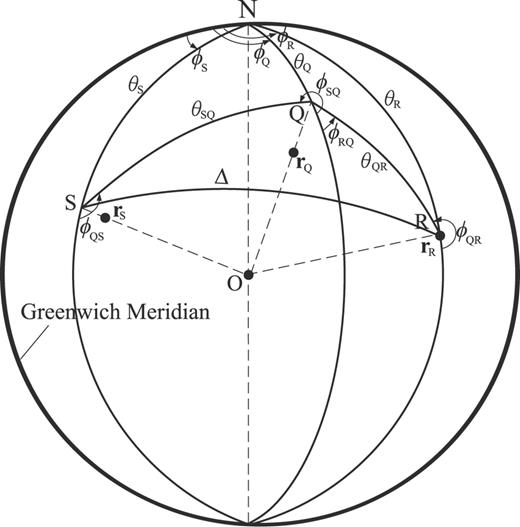
Geometry of the source at rS, receiver at rR, and an arbitrary location rQ at which the Fréchet kernel is being calculated. S, R and Q are the surface projections of rS, rR and rQ, respectively. Here rR and R coincide since the receiver is assumed to be on the surface.


In writing eq. (5), we omitted the source and receiver locations in the argument on the left-hand side to emphasize that the waveform Fréchet derivative varies with the spatial-temporal point (rQ, t) for a given pair of source and receiver.
3.2 Traveltime Fréchet derivatives

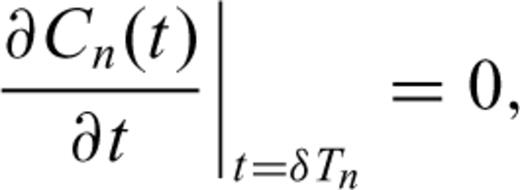



In this formulation,  is a functional dependent upon the starting model as well as the particular seismic observable under consideration. In paper II, we derive these functionals for other types of seismic observables.
is a functional dependent upon the starting model as well as the particular seismic observable under consideration. In paper II, we derive these functionals for other types of seismic observables.



 , the earthquake-generated wavefield from source rS to rQ, and
, the earthquake-generated wavefield from source rS to rQ, and  , the Green's tensor from rQ to receiver rR. Both are evaluated in the reference model.
, the Green's tensor from rQ to receiver rR. Both are evaluated in the reference model.4 FrÉchet Kernels in Terms of Strain Green's Tensors


 in eqs (3–5) and (11) requires that we also define a second important quantity, the fourth-order two-side strain Green's tensor (TSGT)
in eqs (3–5) and (11) requires that we also define a second important quantity, the fourth-order two-side strain Green's tensor (TSGT) 








5 Computation of SGTS by Normal-Mode Summation


In eq. (26), Ylm(θ, ϕ) is the complex surface spherical harmonics (SSH) of angular degree l and azimuthal order m (Edmonds 1960),  is the surface gradient operator, and
is the surface gradient operator, and  and
and  are the three basis vectors of the spherical polar coordinate system. The functions Uk(r), Vk(r) and Wk(r) are radial eigenfunctions for a chosen earth model and are numerically calculated by well-established programs such as MINEOS or OBANI (Woodhouse 1988; Dahlen & Tromp 1998). There are two types of modes: spheroidal modes (S) whose radial eigenfunctions Wk(r) are identically zero, and toroidal modes (T) whose radial eigenfunctions Uk(r) and Vk(r) are both identically zero. As a result, the normal-mode summation in eq. (25) is always separated into a spheroidal-mode summation for the P–SV component waveform and a toroidal-mode summation for the SH component waveform. Due to the spherical symmetry of the reference model, the radial eigenfunctions as well as the eigenfrequencies are independent of the azimuthal order m. Thus, for simplicity, the radial eigenfunctions Uk(r), Vk(r) and Wk(r) can be identified by the single index k = (n, l) that includes the information only on the overtone number and the angular degree. Similarly, the eigenfrequency ωj can also be denoted ωk.
are the three basis vectors of the spherical polar coordinate system. The functions Uk(r), Vk(r) and Wk(r) are radial eigenfunctions for a chosen earth model and are numerically calculated by well-established programs such as MINEOS or OBANI (Woodhouse 1988; Dahlen & Tromp 1998). There are two types of modes: spheroidal modes (S) whose radial eigenfunctions Wk(r) are identically zero, and toroidal modes (T) whose radial eigenfunctions Uk(r) and Vk(r) are both identically zero. As a result, the normal-mode summation in eq. (25) is always separated into a spheroidal-mode summation for the P–SV component waveform and a toroidal-mode summation for the SH component waveform. Due to the spherical symmetry of the reference model, the radial eigenfunctions as well as the eigenfrequencies are independent of the azimuthal order m. Thus, for simplicity, the radial eigenfunctions Uk(r), Vk(r) and Wk(r) can be identified by the single index k = (n, l) that includes the information only on the overtone number and the angular degree. Similarly, the eigenfrequency ωj can also be denoted ωk.






As discussed previously, to compute a Fréchet kernel we need to evaluate the waveform Fréchet kernel  in eq. (19), which depends on the SSGT h and the TSGT H. At each point in space, the evaluation of the SGTs is achieved by the summation of tens of thousands of normal modes for periods of 20 s, which makes the entire calculation rather tedious. One way to reduce the computations necessary to compute the Fréchet kernels is to pre-calculate h and H on a spatial grid and store them on a disk. The required storage would be very expensive for a 3-D model since the SSGTs and TSGTs would then depend on the precise locations of source and receiver. However, for a spherically symmetric Earth model, h (rR; rQ) only depends on |rR | = r0, usually the radius of the Earth, |rQ | = rQ and ΔQR, the angular distance between rQ and rR. Therefore, we can compute h (rR; rQ) for a set of (rQ, ΔQR) values and establish a database for h (rR; rQ). Fig. 2 is an illustration of the (rQ, ΔQR) grid in establishing the database for SSGT h (rR; rQ). Similarly, H (rQ; rS) only depends on |rS | = rS, the earthquake source depth, |rQ | = rQ, and ΔSQ, the angular distance between rS and rQ. We can thus establish a database of TSGT H (rQ; rS) for a set of (rS, rQ, ΔQR) values (see Fig. 3), which can be used in the evaluation of
in eq. (19), which depends on the SSGT h and the TSGT H. At each point in space, the evaluation of the SGTs is achieved by the summation of tens of thousands of normal modes for periods of 20 s, which makes the entire calculation rather tedious. One way to reduce the computations necessary to compute the Fréchet kernels is to pre-calculate h and H on a spatial grid and store them on a disk. The required storage would be very expensive for a 3-D model since the SSGTs and TSGTs would then depend on the precise locations of source and receiver. However, for a spherically symmetric Earth model, h (rR; rQ) only depends on |rR | = r0, usually the radius of the Earth, |rQ | = rQ and ΔQR, the angular distance between rQ and rR. Therefore, we can compute h (rR; rQ) for a set of (rQ, ΔQR) values and establish a database for h (rR; rQ). Fig. 2 is an illustration of the (rQ, ΔQR) grid in establishing the database for SSGT h (rR; rQ). Similarly, H (rQ; rS) only depends on |rS | = rS, the earthquake source depth, |rQ | = rQ, and ΔSQ, the angular distance between rS and rQ. We can thus establish a database of TSGT H (rQ; rS) for a set of (rS, rQ, ΔQR) values (see Fig. 3), which can be used in the evaluation of  using eq. (19). The SGTs can be calculated using an exact full-wave method such as the normal-mode theory. Then, using the SGT database, we can compute full-wave Fréchet kernels by trivial evaluations of eq. (19). In this way, we are able to achieve accuracy with reasonable computational costs.
using eq. (19). The SGTs can be calculated using an exact full-wave method such as the normal-mode theory. Then, using the SGT database, we can compute full-wave Fréchet kernels by trivial evaluations of eq. (19). In this way, we are able to achieve accuracy with reasonable computational costs.
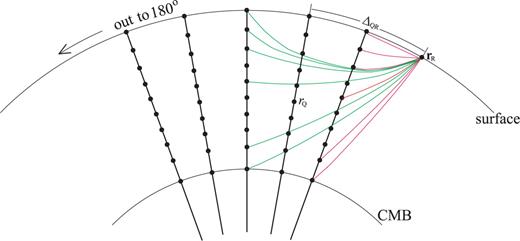
Schematic illustration of the spatial grid used in SSGT database. The receiver rRis fixed on the surface. For every sampling point rQ, 10 time-series (hi in eq. B12) are computed for the SSGT from rQ to rR.
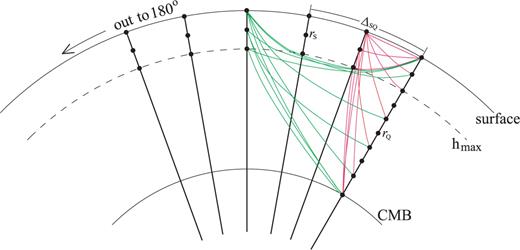
Schematic illustration of the spatial grid used in TSGT database. For each pair of sampling points rS and rQ, 20 time-series (Hi in eq. B15) are computed for the TSGT. h max indicates the maximum known depth of earthquakes and it is the maximum depth that source sampling points rS need to reach.
In evaluating the waveform Fréchet kernel  using eq. (19), since the elasticity tensor perturbation δΛ and the moment tensor M are usually given in spherical polar system with basis vectors
using eq. (19), since the elasticity tensor perturbation δΛ and the moment tensor M are usually given in spherical polar system with basis vectors  and
and  , the databases for the SGTs should also be calculated in the same coordinate system. However, to simplify the normal-mode expressions, we take advantage of the generalized surface spherical harmonics (GSSH) in our derivations. The classical paper by Phinney & Burridge (1973) introduced into seismology the GSSH which made the algebra involved in the analysis of wave propagation and normal modes on a spherical Earth more elegant and less tedious. The GSSH have been used in several studies based on the normal-mode theory (e.g. Woodhouse & Girnius 1982; Boschi & Woodhouse 2006; Yang et al. 2010). Dahlen & Tromp (1998) gives a thorough and very accessible discussion of the GSSH in their Appendix C. We provide a few basic definitions and formulae in Appendix A to make the discussion in the current paper more self-contained.
, the databases for the SGTs should also be calculated in the same coordinate system. However, to simplify the normal-mode expressions, we take advantage of the generalized surface spherical harmonics (GSSH) in our derivations. The classical paper by Phinney & Burridge (1973) introduced into seismology the GSSH which made the algebra involved in the analysis of wave propagation and normal modes on a spherical Earth more elegant and less tedious. The GSSH have been used in several studies based on the normal-mode theory (e.g. Woodhouse & Girnius 1982; Boschi & Woodhouse 2006; Yang et al. 2010). Dahlen & Tromp (1998) gives a thorough and very accessible discussion of the GSSH in their Appendix C. We provide a few basic definitions and formulae in Appendix A to make the discussion in the current paper more self-contained.
 in the generalized coordinate system
in the generalized coordinate system 

 and
and 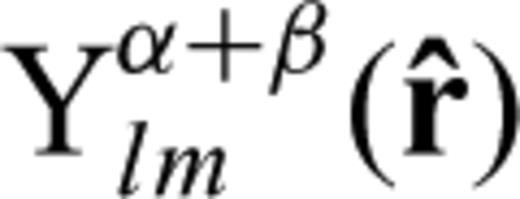 are the GSSH as defined in Dahlen & Tromp (1998). Expressions of the radially dependent functions sαk (r) and ɛαβk (r) are given in Appendix A. Hereafter, Greek letters indicate quantities in the generalized coordinate system. Given the normal-mode expansion of eigenvector and modal strain tensor in the generalized coordinate system, we can derive the expressions of the two SGTs
are the GSSH as defined in Dahlen & Tromp (1998). Expressions of the radially dependent functions sαk (r) and ɛαβk (r) are given in Appendix A. Hereafter, Greek letters indicate quantities in the generalized coordinate system. Given the normal-mode expansion of eigenvector and modal strain tensor in the generalized coordinate system, we can derive the expressions of the two SGTs 




 and the quantities θQR, ϕRQ and ϕQR defined in Fig. 1, the expansion coefficients in eqs (37) and (38) become
and the quantities θQR, ϕRQ and ϕQR defined in Fig. 1, the expansion coefficients in eqs (37) and (38) become 

6 Numerical Implementation and Examples of SGTS
As shown in eqs (30) and (31), the two types of SGTs can be expressed in terms of normal-mode eigenvectors and strains. Therefore, the construction of a SGT database can be realized in two steps: (a) calculating a complete set (up to certain frequency) of normal-mode eigenfunctions for the reference model, that is, the radial functions Uk(r), Vk(r) and Wk(r) in eq. (26) for all possible k values up to the given maximum frequency; and (b) evaluating the summations in eqs (30) and (31) to obtain all elements of the SGTs. The algorithm for calculating normal-mode eigenfunctions is now well established and standard programs such as MINEOS and OBANI (Woodhouse 1988; Dahlen & Tromp 1998) are distributed and used widely by the seismological community. Although Step (b) only involves simple summations of the eigenfunctions, it can be computationally laborious when the number of grid points at which the SGTs are calculated is large. As discussed in Appendix B, even though there are 27 elements in the third-order SSGT h (rR; rQ) and 81 elements in the fourth-order TSGT H (rQ; rS), both types of SGTs have symmetry properties we can exploit such that only 10 functions in eq. (B12) for h (rR; rQ) and 20 functions in eq. (B15) for H (rQ; rS) need to be calculated and stored in the SGT database. This greatly reduces the CPU time and the storage needed to establish the SGT database.
For the source-side SGTs hipq(rR, t; rQ), we calculate the 10 functions defined in eq. (B12), h1, h2, … , and h10, between a set of grid points rQ to a fixed receiver position rR on the Earth's surface (see Fig. 2). The resulting SSGT portion of the SGT database is composed of the 10 functions, h1, h2, …, and h10, sampled on a set of (rQ, ΔQR, t) grid points. If the region of interest is the whole mantle, we can choose rQ to be at a series of depths from the surface down to the core–mantle boundary, ΔQR at a set of epicentral distances from 0 out to 180°, and t up to an appropriate length of time, say 3600 s. The ranges and sampling rates of rQ, ΔQR and t are flexible and should be tuned depending on the particular problem of interest. For example, if one wants to compute 3-D long period surface wave kernels, a coarse time sampling (typically of a few seconds) will be sufficient for a spatial grid covering the upper mantle only. With an average sampling interval of ∼20 km in rQ and uniform sampling rates of 0.2° in ΔQR and 1 s in time, it takes ∼100 hr on a cluster with 20 2.5 GHz processors to compute the 2400-s long SSGTs for the whole mantle by summing normal modes up to 0.3 Hz, and the total disk space to store the SSGT portion of the database is ∼12 GBytes. Two examples of the SSGT are shown in Figs 4 and 5. In all the numerical examples shown in this study we have used model PREM (Dziewonski & Anderson 1981). Plotted in Figs 4 and 5 are the physically more meaningful hipq(rR, t; rQ) defined in (B11), with both rQ and rR on the equator and rR positioned to the east of rQ. In this configuration, the time-series in Fig. 4 are obtained from (B11) using ϕRQ=π/2 and the 10 hi(t) time-series for rQ= 6371 km and ΔQR= 30° extracted from the SSGT database. The time-series in Fig. 5 are obtained in the same way with rQ= 6330 km. Of the 18 independent elements in hipq(rR, t; rQ), only those with significant amplitudes are plotted. All other elements have negligibly small maximum amplitudes. The time-series in Figs 4 and 5 clearly resemble seismograms. By definition, an element hipq(rR, t; rQ) represents the time-series of the ith component of displacement at rR caused by the (p, q)-element of strain at rQ. In fact, an immediate application of the SSGT is the calculation of synthetic seismograms, since the ith component of the displacement caused by a moment tensor M is simply the product Mpqhipq(rR, t; rQ). Figs 6 and 7 show the synthetic seismograms at rR due to a double-couple source at rQ positions in Figs 4 and 5, respectively. To check the accuracy of the SSGT database, we also compared them to synthetic seismograms calculated by standard normal-mode summation procedure. The results are in perfect agreement with those obtained with the SSGT database.

Numerical examples of the SSGT hipq(rR, t; rQ), with both rQ and rR on the equator and rR positioned to the east of rQ. rQ is located on the surface. All time-series have been filtered by a four-pole Butterworth bandpass filter with corner frequencies at 0.002–0.08 Hz and are plotted with the same vertical scale. Only elements with significant amplitudes are plotted.
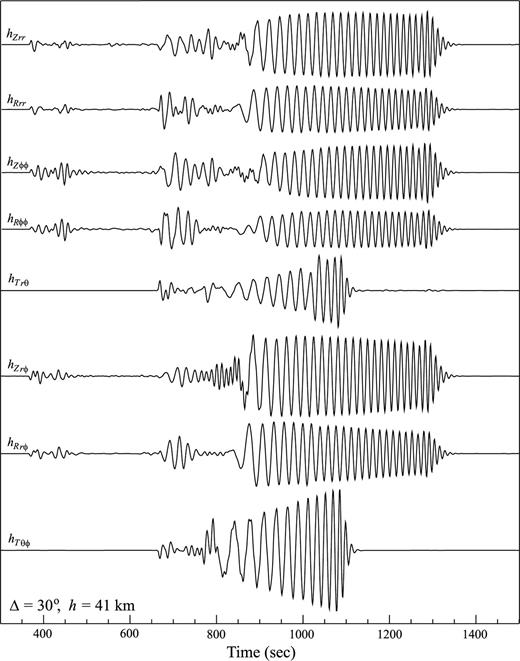
Numerical examples of the SSGT hipq(rR, t; rQ), with both rQ and rR on the equator and rR positioned to the east of rQ. rQ is located at a depth of 41 km. All time-series are filtered by a 4-pole Butterworth bandpass filter with corner frequencies at 0.002–0.08 Hz and are plotted with the same vertical scale. Only elements with significant amplitudes are plotted.
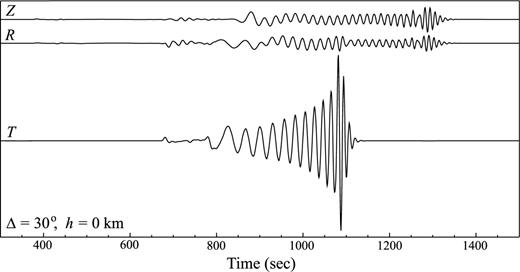
Synthetic seismograms obtained from the SSGTs in Fig. 4. A point source with a focal mechanism of 60°/45°/45° for strike/dip/rake angles has been used. The source time function is such that the moment tensor is a Heaviside function in time.
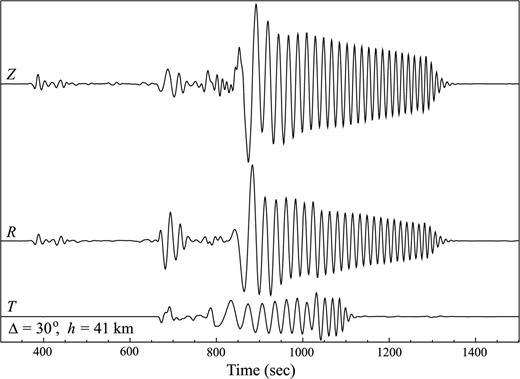
Synthetic seismograms obtained from the SSGTs in Fig. 5. A point source with a focal mechanism of 60°/45°/45° for strike/dip/rake angles has been used. The source time function is such that the moment tensor is a Heaviside function in time.
The SSGT part of the SGT database requires relatively less computation and disk space because only 10 functions h1, h2, … , and h10 are involved and the receiver rR is fixed on the surface. The TSGTs, however, require the calculation of 20 functions H1, H2, … , and H20 in (B15) that need to be stored on a 4-D grid (rS, rQ, ΔSQ, t). The values of rQ and t can be the same as those for SSGT, and ΔSQ can also be sampled on the same grid as that for ΔQR. The depth samples for rS may be limited to 700 km, the maximum possible depth of earthquakes. With the similar sampling parameters for (rQ, ΔSQ, t) to those for the SSGT discussed before but a finer grid size for rS (a total of about 100 samples down to 700-km depth), it takes ∼1000 hr on the same cluster with twenty 2.5 GHz processors to compute the 2400-s long TSGTs for the whole mantle by summing normal modes up to 0.3 Hz, for a total storage volume of ∼1.2 TBytes. Fig. 8 shows examples of the TSGT time-series Hijpq(rQ, t; rS), with both rS and rQon the equator and rQ positioned to the east of rS. Therefore, the TSGTs in Fig. 8 are obtained from (B14) using ϕQS=π/2, ϕSQ= 3π/2 and the 20 Hi(t) time-series for rS= 6334 km, rQ= 6371 km and ΔSQ= 30° extracted from the TSGT database. Similar to the SSGTs in Figs 4 and 5, many of the TSGT elements have negligibly small amplitudes for this rS and rQ configuration and are not plotted.
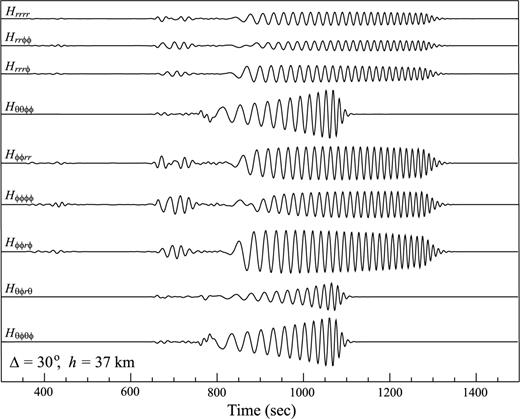
Numerical examples of the TSGT Hijpq(rQ, t; rS), with both rS and rQ on the equator and rQ positioned to the east of rS. rS is located at a depth of 37 km, and rQ is on the surface. All time-series have been filtered by a four-pole Butterworth bandpass filter with corner frequencies at 0.002–0.08 Hz and are plotted with the same vertical scale.
Another way to visualize the spatial variation of the SGTs is to look at their snapshots. In Fig. 9, the SSGT component hTθϕ in the great-circle plane is displayed for the time instants of 400 s, 800 s, 1200 s and 1600 s. From eq. (15) the transverse-component displacement at rR, uT(rR, t; rQ), is proportional to the SSGT element hTθϕ(rR, t; rQ) at rQ. The proportionality factor is simply the moment tensor element Mθϕ. Therefore, a snapshot at time ti represents the amplitude of the transverse-component displacement at rR and ti generated by a unit impulsive moment tensor element Mθϕ= 1 at rQ. It is thus expected that the snapshots in Fig. 9 resemble those of SH-wave fronts emanating from a strike-slip source (e.g. fig. 3.5–19 of Stein & Wysession 2003) at location rR. Fig. 10 shows snapshots for the hZrr component (eq. B11a). The pattern resembles the wave fronts of the P–SV system. Other elements of the SSGT h (rR, t; rQ) can be viewed and interpreted in the same way. For a specific element of the TSGT H (rQ, t; rS), the snapshots will represent the strain, or spatial gradients of the displacement, at rQ and time t, due to a specific element of the moment tensor of unit strength at rS.
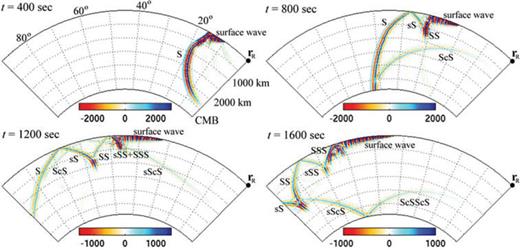
Snapshots of the SSGT hTθϕ(rR, t; rQ) taken at 400 s, 800 s, 1200 s and 1600 s. Receiver location is fixed at rR. Plotted here are the values of hTθϕ(rR, t; rQ) normalized by a factor of 0.952 × 10−25N−1.
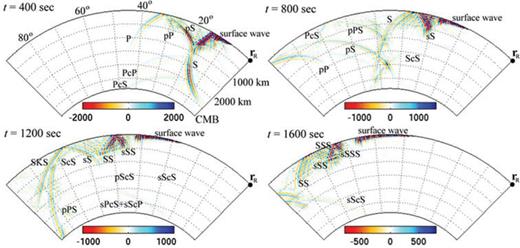
Snapshots of the SSGT hZrr(rR, t; rQ) taken at 400 s, 800 s, 1200 s and 1600 s. Receiver location is fixed at rR. Plotted here are the values of hZrr(rR, t; rQ) normalized by a factor of 0.952 × 10−25N−1.
7 Conclusions
We have shown that by defining the third-order SSGT and the fourth-order TSGT, we can express the perturbation to the displacement from source rS to receiver rR induced by the heterogeneity in structure at an arbitrary location rQ in terms of the convolution between the SSGT from rS to rQ and the TSGT from rQ to rR. By exploiting the fact that the SSGT and TSGT only depend on the reference Earth model, we can pre-calculate and establish a database of the SGTs from which the synthetic seismograms as well as the Fréchet kernels can be evaluated more efficiently. This provides a possibility of conducting full-wave seismic tomography using the non-geometrical seismic signals that cannot be modelled by asymptotic ray theory.
We have derived the expressions of the SSGTs and TSGTs in the context of normal-mode theory and discussed the practical issues in creating a SGT database for the calculation of Fréchet kernels for tomographic studies. In the most general case, the SSGT database consists of 10 time-series distributed on a (rQ, ΔQR) grid; whereas the TSGT database is composed of 20 time-series distributed on a (rS, rQ, ΔSQ) grid. Both the CPU time and disk space needed in calculating and storing the SGT databases are modest. However, the resulting SGT databases enable much more efficient evaluations of Fréchet kernels for tomographic inversions. In Paper II, we will describe the process of deriving the expressions of various kinds of Fréchet kernels in terms of the SGTs and present numerical examples of the kernels to demonstrate the flexibility and efficiency of the SGT approach for applications in seismic tomography.
Acknowledgments
The authors wish to thank Marie Calvet for comments that helped improve the manuscript. Numerical computations have been performed on the HPC clusters at Institute of Earth Sciences, Academia and National Center for High-performance Computing (NCHC) in Taiwan. LZ has been supported by the National Science Council (NSC) of Taiwan under grants NSC95–2119-M-001–063 and NSC96–2116-M-001–011.
Appendices
Appendix A: Normal-Mode Expressions Using Generalized Surface Spherical Harmonics
Here, we provide a few basic expressions of normal-mode solutions in terms of GSSH. Most of the materials here can be found in appendix C of Dahlen & Tromp (1998).
 are defined in terms of the three basis vectors
are defined in terms of the three basis vectors  and
and  in spherical polar coordinate system
in spherical polar coordinate system 

 is the (scalar) generalized surface spherical harmonic. The radial functions sαk (r) can be related to the normal-mode radial eigenfunctions
is the (scalar) generalized surface spherical harmonic. The radial functions sαk (r) can be related to the normal-mode radial eigenfunctions 










Explicit expressions for Pα2m (cos θ) and Pα3m (cos θ) can be found in many mathematical handbooks such as Abramowitz & Stegun (1964).
Appendix B: Expressions for Strain Green's Tensors and Their Normal-Mode Incarnations








 and
and 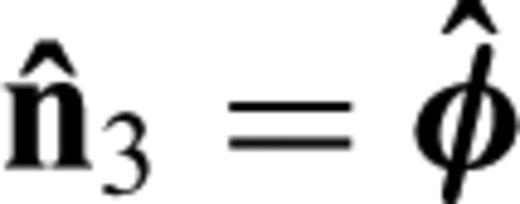 , and the transformation matrix is
, and the transformation matrix is 
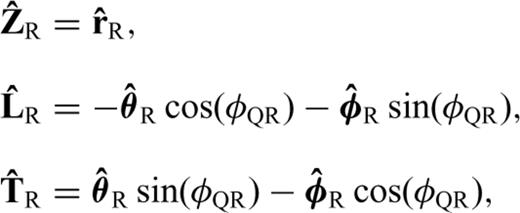
 and
and  are unit vectors in vertical, longitudinal and transverse polarizations, respectively.
are unit vectors in vertical, longitudinal and transverse polarizations, respectively.




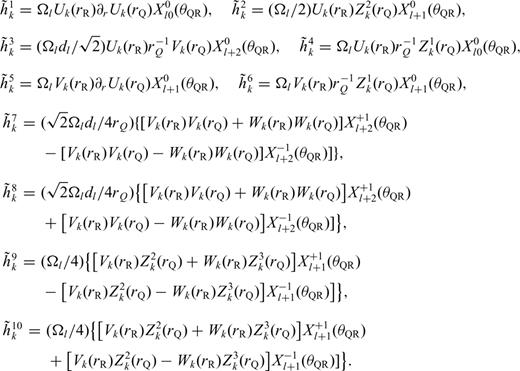
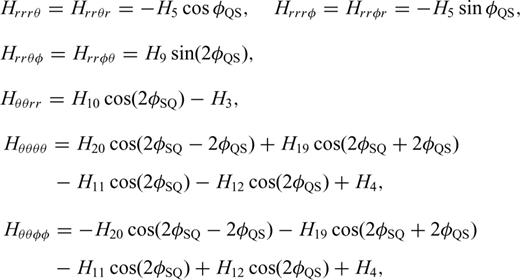
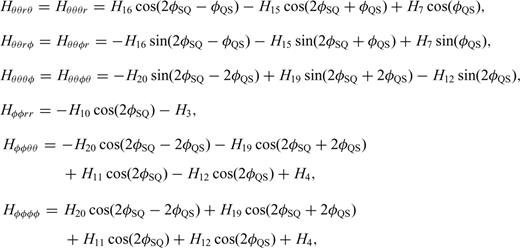

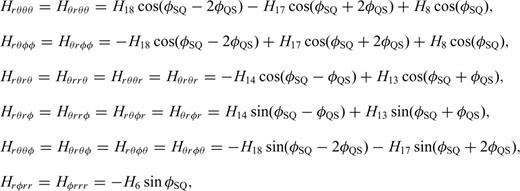
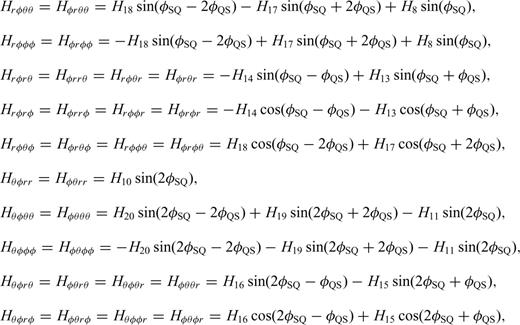



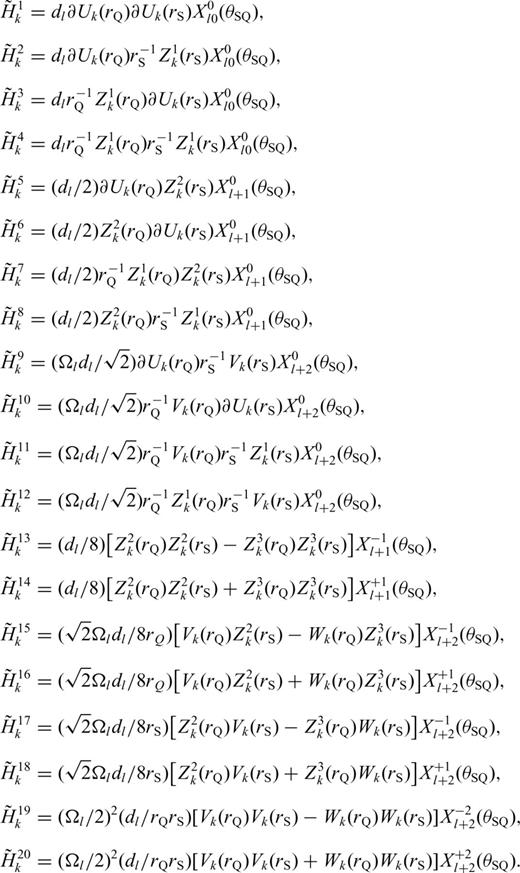
With these definitions, we only need to compute and store the 10 coefficients in eq. (B12) to obtain the 21-element third-order SSGT hi(rR, t;rQ, θQR) in eq. (B11), and the 20 coefficients in eq. (B15) to obtain the 81-element fourth-order TSGT Hi(rQ, t;rS, θSQ) in eq. (B14).
References




